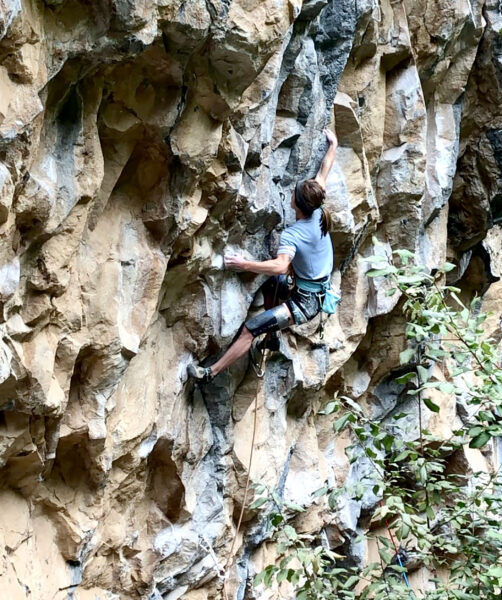
Image by Lucie Hanes
“Climbing is a simple sport,” they said. “Just you against the rock,” they said. And in theory, they’re right. Sometimes, when you’re tens — if not hundreds — of feet above the ground while staring down the crux moves of your climbing project and shaking out the pump pulsating through your forearms, that’s exactly how it feels. Working so hard at such a distance from the next closest human being has a way of cutting you off from the rest of the world. All that seems to exist in that split second of utmost effort is the battle between you and the rock.
In reality, however, nothing could be further from the truth. Don’t get me wrong; it’s a beautiful concept. But the only thing that makes it possible for climbing to feel like a simple test of skill and will is a packload of hyperspecialized gear. Ask most climbers what they value most in life and they’ll tell you without hesitation that they’ll take experiences over items any day. What they fail to mention is the fact that none of the experiences they love so much could happen without a serious investment in items that keep them safe, warm, focused and healthy as they go.
Last fall, I sent my first 5.14 sport climb. That’s a grade I once believed could be my absolute peak, if not completely out of my realm altogether. Now it’s just another rung on a ladder that only continues to rise higher. But this chronically anxious climber couldn’t have gotten there without gear that I can trust to catch me through whipper after whipper and drown out the “real world” long enough to put up my best fight.
Consider this my love letter to all the gear I credit for making my climbing dreams (so far) come true:
Outdoor Vitals KotaUL Pack
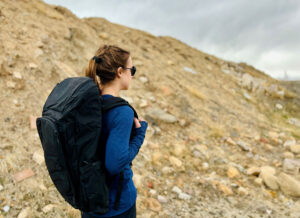
Image by Lucie Hanes
Have pack, will travel. It’s pretty hard to get any of the other items on this list to the crag in the first place without a way to lug it there. But I’ve gotten almost embarrassingly picky with my climbing pack preferences since realizing how much mental energy I expend on the wall. After facing some of my biggest fears and insecurities up there, I find myself reverting to the maturity of a toddler who skipped their afternoon nap in between pitches. The slightest inconvenience has been known to provoke a minor (or major) emotional breakdown. I really wish I was exaggerating, but tears are apparently my body’s instinctual response to exhaustion. C’est la vie.
That’s why I appreciate the KotaUL pack from Outdoor Vitals. It unzips all the way from top to bottom, eliminating the frustration of digging blindly through the depths of a chute-style pocket for the one thing that just so happens to sit right at the bottom of the pile — made worse by all of the pointy objects involved in climbing. I can’t overstate the convenience of being able to lay this pack flat and put my eyes on its entire contents at once. Four other external pockets and eight internal compartments make it possible to divvy up smaller items so they don’t get lost in the main chosspile. It’s not just easy to find what you need, it’s practically brainless — which aligns perfectly with my post-climb state of being.
The KotaUL is also featherlight at just under three pounds. Climbing equipment might have lightened up over the years, but there’s only so many ounces you can cut while still expecting it to save your life. At least a lightweight pack means the majority of the burden on your back comes from the gear itself.
The same fabric responsible for the weight savings also makes the KotaUL durable enough to withstand plenty of poking and prodding from all the aforementioned pointy objects inside. Outdoor Vitals then transferred a lot of the features that other companies place on the outside of their packs to the inside of the KotaUL, like the compression straps. So, you’re left with a sleek, low-profile exterior that resists snags as you shinny between trees and scramble through boulder gardens.
I expect this pack to stick around for the next decade or until I reach 5.15, whichever comes second.
Arc’teryx Skaha Harness
My biggest issue with harnesses in the past is the lack of flexibility. If there’s one thing that’s pretty indisputable in climbing, it’s the need for freedom of movement. This sport is all about flexibility and exerting strength at the limits of your range of motion. That’s tough to do when your harness is so restrictive around your hips that you might as well be wearing Olivia Newton John’s skintight leather pants. The Arc’teryx Skaha Harness uses honeycomb mesh infused with aptly-named “warp strength technology” to stay supple. Heavy-duty, reinforced gear loops support as many quickdraws as any single-pitch route could call for. But that’s the only part of this harness that could possibly earn “heavy” as a descriptor. The best climbing harness is the one that feels like it’s nonexistent, and the Skaha delivers in that arena.
My favorite feature, though, is a subtle one. The elastic band that connects the leg loops with the waistbelt in the back is not only slim and stretchy enough to keep from digging into your butt cheeks, but it also attaches to the waist belt via a quick-release hook. That can only mean one thing: breezy bathroom breaks. You heard me, ladies. No more taking off your entire harness every time you need to pee. This is the crag day game-changer you didn’t know you needed.
Scarpa Drago LV and Instinct VS Climbing Shoes
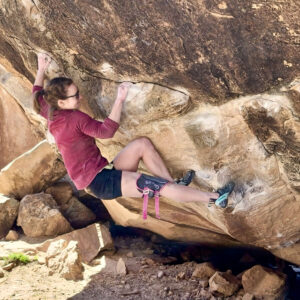
Image by Lucie Hanes
I’m a big fan of super soft climbing shoes with thin, sensitive rubber that allows me to actually feel the footholds. Otherwise, I end up fumbling around on the rock like a clown on stilts. I need to be able to discern details in the rock in order to pinpoint the exact placement of my toes. The harder the grade, the more precise the positioning needs to be. But shoes that are too soft contribute to excess foot fatigue. It’s a careful balance.
The Scarpa Drago LV rides the line well for me. LV stands for Low Volume, which means this version of the shoe has a shallow heel and toe for flatter, narrower feet (so those with higher-volume feet should go for the original Drago instead). This highly malleable shoe conforms to the rock as it finds the textures and ripples on the surface. Where other shoes seem to simply rest on top of those features, the Drago seems to envelop them in rubber for greater grip. The aggressive toe can take advantage of tiny divots on slab, then flatten on command to maximize surface area on steep walls and tension-dependent moves.
When I need slightly more rigidity underfoot, I’ll pull out the Instinct VS instead. Thicker rubber, and more of it around the entire shoe, provides more security on small edges and tenuous heel hooks. The Instinct also gives me an extra millimeter or two of reach on especially spanny moves, which makes a difference for this child-sized climber.
(Full disclosure: At the time of this writing, I’m a Scarpa sponsored athlete in the climbing and ultrarunning spaces, but I was wearing Scarpa footwear long before their reps came knocking.)
Petzl Spirit Express Quickdraws
If it ain’t broke, don’t fix it — nor switch to an alternative. Petzl Spirit Quickdraws have held OG status for decades, and I haven’t yet found a reason to consider changing things up. Petzl keeps up with the times and technology by issuing regular updates of the Spirits while staying true to the classic design that earned their fanbase. The latest iteration takes a new shape that’s shorter and narrower than the previous model so it fits better in your hand for a more comfortable, controlled grip when clipping. My puny hands certainly appreciate the shrinkage. These draws also cut 2 grams per carabiner thanks to three cut-outs in the metal. When you’re racking 10 or more quickdraws for a long route, the savings add up.
The new Spirits also feature a key aesthetic difference that serves a functional purpose too. Petzl has made the dogbone darker and the carabiner lighter in color so the two are more easily distinguishable from one another. This is unexpectedly helpful when gauging how far you have to reach as you move to clip in the rope, especially since the draws come in three different lengths.
Mammut Crag We Care Rope

Image by Lucie Hanes
I’ve waxed poetic long enough about this rope in my long-form review of Mammut’s Crag We Care, so I there’s a lot I don’t need to rehash. But this rope remains my go-to for redpoint efforts. If I know I’m going to be hangdogging the day away on a new project, I might pull out a thicker workhorse that can stand to take more of a beating. When it’s time to go for the send, though, this one goes with me. It’s a rope I feel good about using and abusing because it’s made from the recycled byproducts of other ropes. The Crag We Care Rope gives new life to old yarn that would otherwise clog up the landfill.
And as I mentioned in my earlier ActionHub review, climbers go through a lot of rope. It’s the one piece of gear that you really don’t want to gamble with, because that means gambling with your life. This rope makes that feel like less of a necessary evil.
Besides the sustainability factor, the Crag We Care Rope is insignificant in the best way possible. Just like my harness, I don’t really want to notice my rope until it comes to the rescue when I take a whip. This one clearly does its job well, considering that I’m still around to sing its praises. It’s thin yet sturdy, smooth yet steady, and subtle yet reliable. I couldn’t ask for much more out of a woven hunk of yarn.
Chalk Cartel Climbing Chalk
I don’t sweat much. Really. I’m the type who can wear the same shirt for days on end without repelling all of my friends until laundry day. But the one place that doesn’t hold true is my hands. These paws start dripping like a leaky faucet the second I start climbing. My belay partner likes to make fun of me for the amount of chalk that I go through, but I swear I need it all. A lot of chalk on the market contains some pretty sketchy ingredients though. I’ll be curious to see the state of our lungs in 20 years after breathing in the dust for so long.
Until then, I use Chalk Cartel in an attempt to minimize the damage. This chalk doesn’t use extra drying agents, heavy metals, fillers, or additives to supplement the magnesium carbonate. It doesn’t dry up my hands to the point of cracking and bleeding either. It’s also cheap in bulk (but for my needs, that’s just standard size).
Appalachian Gear Company 8020 Sun Hoodie
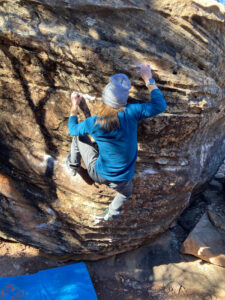
Image by Lucie Hanes
I’m really bad at remembering to wear sunscreen. But I’m apparently really good (genetically) at getting skin cancer. The two don’t mix well. So I’ve stopped trying to lotion up my pasty white shoulders and wear Appalachian Gear Company’s 8020 Sun Hoodie instead. It’s made from alpaca wool, which means the material does a great job of regulating temperature. The 8020 is warm in the chilly morning air, cool under the noon sun, and warm again by dusk. No burns, no chills, no sweat — literally. And don’t be afraid to let it live in your climbing pack, either. Alpaca wool won’t wrinkle or stink for months. I don’t actually think I’ve ever washed mine. I promise it still passes the sniff test.
Mountain Hardwear Ghost Whisperer Down Pants and Phantom Belay Down Parka
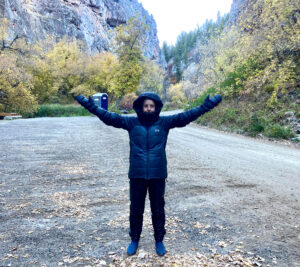
Image by Lucie Hanes
Born and raised in the heat of Virginia, I’m the type to turn blue on a 60 degree day. This has put an early cap on my climbing season in the past because I simply got too cold to feel my fingers on the rock or even safely belay my partner. But last year, I decided that I’d rather look ridiculous than freeze or stay inside. I definitely resemble the Michelin Man in this down suit constructed from Mountain Hardwear’s Phantom Belay Down Parka and Ghost Whisperer Down Pants. It’s well worth the hilarity to feel more comfortable and functional on cold, cloudy crag days.
Yes, this parka was made for the alpine. No, my sport climbing objectives don’t take me anywhere near treeline. But you’d never know it from the intensity of my shivers with the slightest breeze. This behemoth of a jacket keeps me so toast that I’m ready to take it off by the time my turn to climb comes around. That’s a welcome change from how difficult it was to leave the car, let alone climb an entire route, without it to envelop me in warmth between pitches. And for anyone that hasn’t tried down pants, you’re in for a treat. I prefer to climb in low-profile clothing like leggings and tight tops that won’t catch in the wind or snag on the rock. The ability to throw on a pair of down pants over light, breathable leggings as soon as I finish climbing makes the downtime less daunting. I’ve been able to start my days and my seasons earlier, end them later, and stop giving my partner grief about taking too long on the wall.
Ombraz Armless Sunglasses

Image by Lucie Hanes
I’ve broken or lost no less than five pairs of sunglasses when my fingers have flown back in the middle of a dynamic move and caught on the arms, flinging them off of my head and down to the ground 50 feet below. You should have seen my face when I learned that the solution to my flailing actually exists: armless sunglasses. I worried that the Ombraz Armless Sunglasses would give off Inspector Gadget vibes, or maybe even high school science lab goggles, but in practice they’re not at all dorky. You’d never be able to tell that they use flexible straps instead of stiff arms from a distance. Said straps are sturdy enough to provide structure, so they don’t have to suction up against your eye sockets like goggles to stay on, yet flexible enough to conform to the shape of your head. That way, they can fit under hats, hoodies, and helmets and also avoid becoming collateral damage.
The arms and hinges on sunglasses are usually the first parts to break, too. By eliminating the weakest links, Ombraz has created sunnies fit to last much longer than your average pair, even if you don’t send them flying into the sky. Without arms they’re slim enough to fit into the most tightly packed pockets and won’t get squashed. And if you’re still worried about not looking cool, even though you will, remember that you’ve already ruined that by the way you spend your spare time taking the hard way to the top of a cliff.
Sans Meal Bars

Image by Lucie Hanes
No more wimpy granola bars that sustain me for about five minutes. True, I have a faster metabolism than most, and anyone who’s spending sunup to sundown climbing, belaying, and agonizing over their project could likely use a lot of food to keep from passing out or getting hangry. In case you need a refresher: calories = energy = fuel for sending. Sans Meal Bars pack ‘em in without resorting to straight sugar. Not that there’s anything wrong with sugar, especially as a quick source of carbs for climbing. It’s just that you can’t subsist very long on gummy bears alone.
These bars get their energy from dates, egg whites, nuts, and even spinach. You get the same nutritional benefit as a bowl of tofu veggie stir fry, minus the bulk (and the sadness of a cold Tupperware meal). I pound a Sans as one of many crag snacks in a day, but it’s the one I look forward to most.
Lucie Hanes is an avid writer and adventurer on rock and trail with a passion for sharing her outdoor enthusiasms through journalism and mental strength consultation.
 Your Privacy Choices
Your Privacy Choices
 The
The